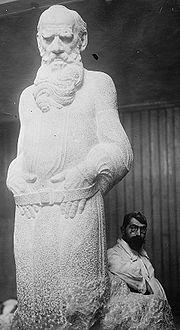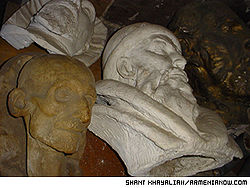
Sergey Merkurov
Encyclopedia

Soviet people
Soviet people or Soviet nation was an umbrella demonym for the population of the Soviet Union. Initially used as a nonspecific reference to the Soviet population, it was eventually declared to be a "new historical, social and international unity of people".-Nationality politics in early Soviet...
sculptor-monumentalist of Greek
Greeks
The Greeks, also known as the Hellenes , are a nation and ethnic group native to Greece, Cyprus and neighboring regions. They also form a significant diaspora, with Greek communities established around the world....
-Armenian descent. He was a People's Artist of the USSR
People's Artist of the USSR
People's Artist of the USSR, also sometimes translated as National Artist of the USSR, was an honorary title granted to citizens of the Soviet Union.- Nomenclature and significance :...
, an academic at the Soviet Academy of Arts, and director of the Pushkin Museum of Fine Arts from 1944 to 1949. Merkurov was considered the greatest Soviet master of post-mortem masks .
He was the author of the three biggest monuments of Joseph Stalin
Joseph Stalin
Joseph Vissarionovich Stalin was the Premier of the Soviet Union from 6 May 1941 to 5 March 1953. He was among the Bolshevik revolutionaries who brought about the October Revolution and had held the position of first General Secretary of the Communist Party of the Soviet Union's Central Committee...
in the USSR.
He was the cousin of George Ivanovich Gurdjieff
G. I. Gurdjieff
George Ivanovich Gurdjieff according to Gurdjieff's principles and instructions, or the "Fourth Way."At one point he described his teaching as "esoteric Christianity."...
, an Armenian-Greek mystic
Mysticism
Mysticism is the knowledge of, and especially the personal experience of, states of consciousness, i.e. levels of being, beyond normal human perception, including experience and even communion with a supreme being.-Classical origins:...
and spiritual teacher.
Biography
Sergey Merkurov was born in Alexandrapol (modern GyumriGyumri
Gyumri is the capital and largest city of the Shirak Province in northwest Armenia. It is located about 120 km from the capital Yerevan, and, with a population of 168,918 , is the second-largest city in Armenia.The name of the city has been changed many times in history...
, Armenia
Armenia
Armenia , officially the Republic of Armenia , is a landlocked mountainous country in the Caucasus region of Eurasia...
). He left the Kiev Polytechnic Institute
Kiev Polytechnic Institute
The National Technical University of Ukraine “Kyiv Polytechnic Institute” is a major university in Kiev, Ukraine.-History:The institute was founded in 1898. At that time it had four departments: Mechanical, Chemical, Agricultural, and Civil Engineering. The first enrolment constituted 360 students...
after a political scandal and moved to Switzerland
Switzerland
Switzerland name of one of the Swiss cantons. ; ; ; or ), in its full name the Swiss Confederation , is a federal republic consisting of 26 cantons, with Bern as the seat of the federal authorities. The country is situated in Western Europe,Or Central Europe depending on the definition....
, where he became a student of Adolf Mayer
Adolf Mayer
Adolf Eduard Mayer was a German agricultural chemist whose work on tobacco mosaic disease played an important role in the discovery of tobacco mosaic virus and viruses in general....
.
He attended art college in Germany
Germany
Germany , officially the Federal Republic of Germany , is a federal parliamentary republic in Europe. The country consists of 16 states while the capital and largest city is Berlin. Germany covers an area of 357,021 km2 and has a largely temperate seasonal climate...
(1902-05) and then entered the Auguste Rodin
Auguste Rodin
François-Auguste-René Rodin , known as Auguste Rodin , was a French sculptor. Although Rodin is generally considered the progenitor of modern sculpture, he did not set out to rebel against the past...
studio in Paris
Paris
Paris is the capital and largest city in France, situated on the river Seine, in northern France, at the heart of the Île-de-France region...
.
Merkurov had met Vladimir Lenin
Vladimir Lenin
Vladimir Ilyich Lenin was a Russian Marxist revolutionary and communist politician who led the October Revolution of 1917. As leader of the Bolsheviks, he headed the Soviet state during its initial years , as it fought to establish control of Russia in the Russian Civil War and worked to create a...
when the revolutionary leader was living abroad, and listened to his speeches. Among many others, the statue of Lenin that stood in Lenin Square, Yerevan
Yerevan
Yerevan is the capital and largest city of Armenia and one of the world's oldest continuously-inhabited cities. Situated along the Hrazdan River, Yerevan is the administrative, cultural, and industrial center of the country...
during Soviet times also was the work of Merkurov.

Russian Empire
The Russian Empire was a state that existed from 1721 until the Russian Revolution of 1917. It was the successor to the Tsardom of Russia and the predecessor of the Soviet Union...
in 1907 as he was called by the Armenian Apostolic Church
Armenian Apostolic Church
The Armenian Apostolic Church is the world's oldest National Church, is part of Oriental Orthodoxy, and is one of the most ancient Christian communities. Armenia was the first country to adopt Christianity as its official religion in 301 AD, in establishing this church...
authorities to execute a post-mortem mask of Catholicos
Catholicos
Catholicos, plural Catholicoi, is a title used for the head of certain churches in some Eastern Christian traditions. The title implies autocephaly and in some cases is borne by the designated head of an autonomous church, in which case the holder might have other titles such as Patriarch...
Mkrtich Khrimian
Mkrtich Khrimian
Mkrtich Khrimian , also known as Khrimian Hayrik , was an Armenian writer, newspaper editor, and political and religious leader. He served as the Armenian Patriarch of Constantinople , Prelate of Van and Catholicos of All Armenians...
. It was his first work of this kind. Then he lived in Tbilisi
Tbilisi
Tbilisi is the capital and the largest city of Georgia, lying on the banks of the Mt'k'vari River. The name is derived from an early Georgian form T'pilisi and it was officially known as Tiflis until 1936...
, Yalta
Yalta
Yalta is a city in Crimea, southern Ukraine, on the north coast of the Black Sea.The city is located on the site of an ancient Greek colony, said to have been founded by Greek sailors who were looking for a safe shore on which to land. It is situated on a deep bay facing south towards the Black...
, Moscow
Moscow
Moscow is the capital, the most populous city, and the most populous federal subject of Russia. The city is a major political, economic, cultural, scientific, religious, financial, educational, and transportation centre of Russia and the continent...
, and made post-mortem (death) masks of Leo Tolstoy
Leo Tolstoy
Lev Nikolayevich Tolstoy was a Russian writer who primarily wrote novels and short stories. Later in life, he also wrote plays and essays. His two most famous works, the novels War and Peace and Anna Karenina, are acknowledged as two of the greatest novels of all time and a pinnacle of realist...
, Hovhannes Tumanyan
Hovhannes Tumanyan
Hovhannes Tumanyan , is considered to be one of the greatest Armenian poets and writers. His work was mostly written in tragic form, often centering on the harsh lives of villagers in the Lori region.-Biography:...
, Vladimir Lenin
Vladimir Lenin
Vladimir Ilyich Lenin was a Russian Marxist revolutionary and communist politician who led the October Revolution of 1917. As leader of the Bolsheviks, he headed the Soviet state during its initial years , as it fought to establish control of Russia in the Russian Civil War and worked to create a...
and his wife, Maxim Gorky
Maxim Gorky
Alexei Maximovich Peshkov , primarily known as Maxim Gorky , was a Russian and Soviet author, a founder of the Socialist Realism literary method and a political activist.-Early years:...
, Vladimir Mayakovsky
Vladimir Mayakovsky
Vladimir Vladimirovich Mayakovsky was a Russian and Soviet poet and playwright, among the foremost representatives of early-20th century Russian Futurism.- Early life :...
and other famous persons. The technique itself is not an easy process. The author pours plaster on the body's face and puts a thread in the middle of it. Then, another material like bronze or plaster is poured inside the mask and this is how an actual-size face of the deceased results.
Merkurov was an outstanding representative of academic modern style, employing the themes of death and stone blocks. As a philosopher of the arts, Merkurov also used motifs of thought (Monument of Dostoevsky, 1911-1913; The figure-portrait of Thought, 1918).
Merkurov was known as a free-thinker and an extraordinary person. He was a member of the Masonic "United Workers' Brotherhood", the Association of Painters of Revolutionary Russia and the Communist Party of the Soviet Union
Communist Party of the Soviet Union
The Communist Party of the Soviet Union was the only legal, ruling political party in the Soviet Union and one of the largest communist organizations in the world...
.
As director of the Pushkin Museum of Fine Arts, he saved the monument of Catherine the Great
Catherine II of Russia
Catherine II, also known as Catherine the Great , Empress of Russia, was born in Stettin, Pomerania, Prussia on as Sophie Friederike Auguste von Anhalt-Zerbst-Dornburg...
and secretly sent it to Yerevan
Yerevan
Yerevan is the capital and largest city of Armenia and one of the world's oldest continuously-inhabited cities. Situated along the Hrazdan River, Yerevan is the administrative, cultural, and industrial center of the country...
, where it was hidden for decades and finally returned to Russia
Russia
Russia or , officially known as both Russia and the Russian Federation , is a country in northern Eurasia. It is a federal semi-presidential republic, comprising 83 federal subjects...
in 2006 .
For Joseph Stalin
Joseph Stalin
Joseph Vissarionovich Stalin was the Premier of the Soviet Union from 6 May 1941 to 5 March 1953. He was among the Bolshevik revolutionaries who brought about the October Revolution and had held the position of first General Secretary of the Communist Party of the Soviet Union's Central Committee...
's 70th birthday, Merkurov made a special gift, a costly granite monument called "Death of the Leader". Stalin refused to accept it and a difficult period in the sculptor's life began.
Merkurov was honored with burial at the Novodevichy Cemetery
Novodevichy Cemetery
Novodevichy Cemetery is the most famous cemetery in Moscow, Russia. It is next to the 16th-century Novodevichy Convent, which is the city's third most popular tourist site. It should not be confused with the Novodevichy Cemetery in Saint Petersburg....
in Moscow. In 1953 his Notes of a Sculptor was published.

